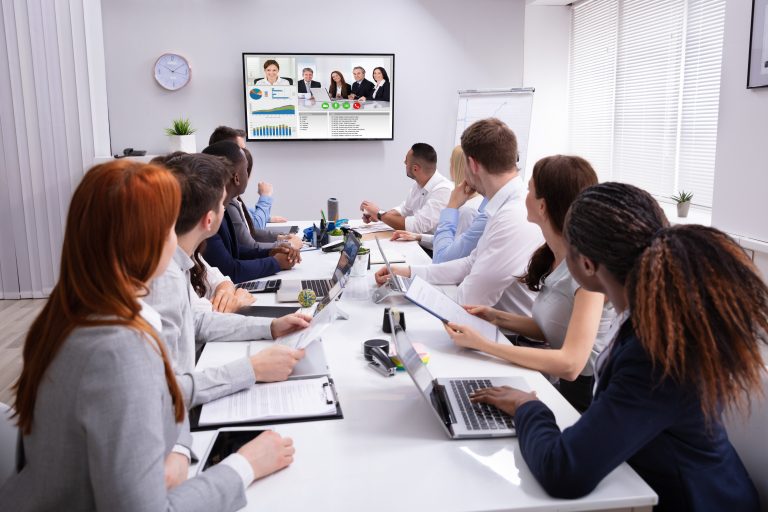While face-to-face meetings are a reliable and effective way for a lot of people to get something done, conference calls remain a necessary and important part of doing business. With employees and workforces continuing to spread further and further apart, conference calls are often the only way that virtual teams can all come together for a meeting.
So, how do you host an effective and productive conference call? In this post we’ll cover some of the most fundamental conference call tips for leading productive calls and how they benefit virtual teams. Whether you’re leading your first meeting, or just want to push your business to have more effective calls, these tips will help you get the most out of every single conference call.
1. Make an Agenda and Stick to It
The first of our conference call tips is simple: be prepared. As is the case with every meeting, good preparation is key to having good conference calls. Just because a meeting is taking place over the phone instead of in-person doesn’t mean you can get away with being unprepared.
Make sure you have a good agenda set ahead of the call. In the agenda, lay out the objective of the call, and set a timeline for each topic that needs to be discussed. Then, if certain participants should lead different sections of the call, it’s vital to assign each section to the corresponding employee or participant. This will ensure that as you transition from one section of the call to the next, no one will be surprised when you ask them to take over the call.
Undoubtedly, you (or whoever is hosting the call) will put a lot of work into the agenda. Stick to it! Announce your role as the call leader and move the call from topic to topic while actively encouraging participation. And here’s a pro-tip that we’ve learned from attending conference calls ourselves: when creating your conference agenda, schedule in some time at the end of the call for any additional comments or questions. This way, if someone gets off topic, there is a designated time slot to reroute them. In the end, if there is something really important to discuss that’s absorbing a lot time on the call and not on the agenda, it might be time to schedule a separate conference call.
2. Send Clear Call-In Instructions
Our second conference call tip also revolves around the practice of being well-prepared. Make sure you send out clear and detailed instructions on how to join the call at least an hour before the meeting. Dial-ins, access codes, and PINs can be cumbersome, so make sure the invite includes all the necessary details.
For even easier call-joining instructions, try using a conference plan from Branded Bridge Line. Each of our plans includes unique numbers with PIN-free dial-ins, so you won’t have to worry about people entering the wrong PIN and joining the call late.
Ready to Host More Effective Meetings?
See how you can put these tips to use and schedule a free demo today.

3. Set Out Clear Call Etiquette Guidelines Ahead of Time
Phone conference etiquette is vital. It might seem cumbersome to lay out rules before a call, but ideally you will only have to share expected conference call etiquette once. Figure out which phone conferencing policies are most important to you, then send out a list of clear guidelines to ensure everyone in the company knows what is expected of them on calls.
As you look through the conference call tips below, you’ll get to see our unique take on various etiquette guidelines that are important to having a good call. Over the course of our time providing the best conference call service in the market, we’ve identified the ones we think are most important.
4. Start on Time and Set Expectations
Start calls on time and don’t wait for stragglers. It’s inevitable that someone will join a call late at some point. One of the worst things you can do is stop what you’re talking about and start the call over. That will only serve to communicate that it’s okay to join calls late. If someone is late joining a call, simply ask that someone else catch them up on the details they missed at the end of the call.
At the start of the meeting, set expectations for undivided attention. In exchange for their attention, offer a fast, efficient call. Snow days are rarely applicable to adults but finish a scheduled 60-minute meeting in 32 minutes and everyone will feel like they just got out of school early.
5. Announce Yourself When You Join
As far as conference call tips go, this one can get overlooked, especially if your company has a lot of calls. That being said, you should always announce your presence when you
join a call. Imagine if you didn’t know someone joined a call and found out after you had a
semi-private conversation. Announcing your presence instills trust, so all participants know exactly who’s on the call at any given point. If you arrive late, wait for a break in the conversation to introduce yourself. Don’t waste time giving reasons for your late arrival; simply give a quick apology for the tardiness, state your name and job role, and allow the conversation to continue.
On a similar note, you should also say your name before you speak. When it comes to tips for large conference calls with many participants, this one is vital. Voices can sound the same, and you don’t want people stopping to think, “Wait, who just said that?” Announce your name, and then make your contribution. Continue to indicate who you are when you’re speaking until people start to recognize your voice. Or, better yet, use a conference calling service that identifies the speaker in a call dashboard.
6. Take Advantage of Your Conference Call Tools
Your conference calls are only as good as the tools you use! Conference calling services are getting more intelligent and are constantly providing you with new mechanisms for managing call efficiency. Pick a service that gives you a visible dashboard with tools to mute participants, boot noisy callers off the call, have a sidebar conversation with certain participants, or even secretly nudge a colleague who isn’t paying attention.
And what conference call toolkit would be complete without call recording? Remembering details from a conference call can be challenging, even with notes. Some conference calling services offer free call recordings. Take advantage of them. They are invaluable.
As an experiment, try recounting the details of a discussion and then listen to the recording. Notice not only the detail you didn’t capture in your notes or memory, but the verbal cues and intonation that give the information context. Get in the habit of attaching call recordings to Evernotes or other notetaking software for everyone to be able to refer back to.
7. Mute Your Line When You Aren’t Speaking
Any extraneous noise can be extremely distracting during a call. The strangest places
have become acceptable places to have conference calls: bathrooms, restaurants, cars, airport security. These “remote offices” have a high likelihood of producing distraction, tangential comments, and communication difficulties. If you’re someone who takes conference calls on the go, we’re not here to chide you for it. In fact, we respect your hustle! Just make sure to hit mute whenever you’re not speaking to minimize noisy distractions.
This conference call tip extends to those in quiet office environments, too. Everyone has experienced this at one point or another: Someone on the call forgets to mute their line and decides to have a separate conversation with another colleague in the room. Mortification ensues as the rest of the call participants grow silent, and the non-muted culprit realizes their grave mistake. As a courtesy to others, and to ensure the call moves as quickly as possible, always put your phone on mute when you aren’t talking.
To that end, make sure you are not putting the conference call on “hold.” This causes
hold music to play for the rest of the callers, immediately halting any progress being made on the call. If you need to leave the call for any reason, it’s best to let the other participants know that you’ll briefly be signing off and catching up with a colleague later to find out what you missed.
8. Keep Comments Short and to the Point
Let’s face it, no one likes to hear you talk more than you do. Keep that in mind so that you can keep your comments short and to the point. Create openings for others to talk and solicit input from people who are reluctant to jump in. Resist the temptation to solve every problem. Agree to address lengthy conversations outside of the call.
We all know that everyone has something they’d rather be doing than attending a meeting. As you put these conference call tips into action, try your best to keep your comments brief and on-topic and encourage others to do the same. Everyone will thank you in the end.
9. Don’t Interrupt or Talk Over Others
It’s hard enough for some people to read non-verbal cues when you’re sitting across from them. During conference calls, this difficulty is compounded by the fact that people cannot see each other at all, making it easier to dominate a conversation, interrupt someone who’s talking, or ignore input. In many ways, the chaos caused by a waterfall of interruptions is worse on a conference call than in a regular meeting! There has to be an acute awareness of these behaviors in order to conquer the conference call.
We know it can be difficult to track who’s talking on conference calls with a lot of
participants. Do your part to make sure things don’t turn into chaos by waiting for everyone on the call to finish their thought before contributing yours. If you know there will be a lot of participants on the call, or participants who have a propensity to interrupt others, consider selecting a mediator at the beginning of the call to facilitate the conversation.
10. Verbally Request Comments and Feedback
For the most part, people are inclined to stay quiet on calls and only speak when directly asked to do so. If you are making an important decision on your call and someone is silent, don’t assume they are in agreement. The fastest way to clarify if someone is on board is to ask them directly. It might sound obvious, but this conference call tip is
often overlooked.
If you notice that someone is not participating on the call at all, asking them for feedback can be a quick way to get them to actively join the conversation. After presenting something on a call, a fast and easy way to ignite conversation is to ask specific people for specific feedback on what you’ve laid out. It might seem scary to get everyone’s opinions on your ideas, but it’s worse to have to wait until after the conference call to find out that someone has critiques. Plus, you might find out they love what you had to say!
11. Repeat Important Comments and Contributions
One downfall of conference calls is that visual cues are totally missing. It’s easy for people in remote locations to get distracted by whatever they are doing separate from the
call. Keeping everyone engaged and focused can be challenging in any meeting, but conference calls bring their own unique set of challenges. The temptations of multitasking can be enticing, and productivity can wane quickly.
For this reason, it’s important to repeat any important comments as a way to helpfully reiterate what they might have missed.
A common theme in these later conference call tips is disrupting silence. People are inclined to fly under the radar if possible. You may find that calls become more active and even faster if you directly call on everyone to participate verbally. After someone has
made an important contribution to the call, repeat what they said and then ask another participant to weigh in.

Bonus Tips: Pro Conference Call Tips for International Meetings
Because we specialize in toll-free international conference calls, our top conference call tips wouldn’t be complete without some advice for our out-of-country callers! Here are a couple bonus conference call tips for businesses who host participants from international locations.
Bonus Tip 1: Consider local time zones when scheduling the call.
It can be difficult to find a time that works for everyone, but calls are more productive when participants don’t have to stay at work late or wake up early just to be on a call.
Bonus Tip 2: Provide a local dial-in number.
When it comes to international conference call tips, you should consider getting a local dial-in so international participants can avoid paying long-distance calling fees when joining the meeting. Branded Bridge Line conference call service offers local numbers in more than 80 countries and every area code in the United States. Providing a local dial-in number can also provide a nice touch if you’re trying to impress international clients with a nod to their locale.
Start Having More Productive Conference Calls
These may seem like a lot of conference call tips to remember, but keep in mind that most are just common courtesy. After you set up phone conference guidelines for your company as a whole, you’ll have an easy reference point to keep track of and remember them. Plus, once you start using them, they’ll quickly become a habit and your calls should become quicker and more productive!
Conference calls can be intimidating, but with the right preparation and clear call guidelines they can at least be effective and productive. Now that you know the best conference call tips, it’s time to take a look at all of the conference call features Branded Bridge Line has to offer so you can start having more productive conference calls today!



